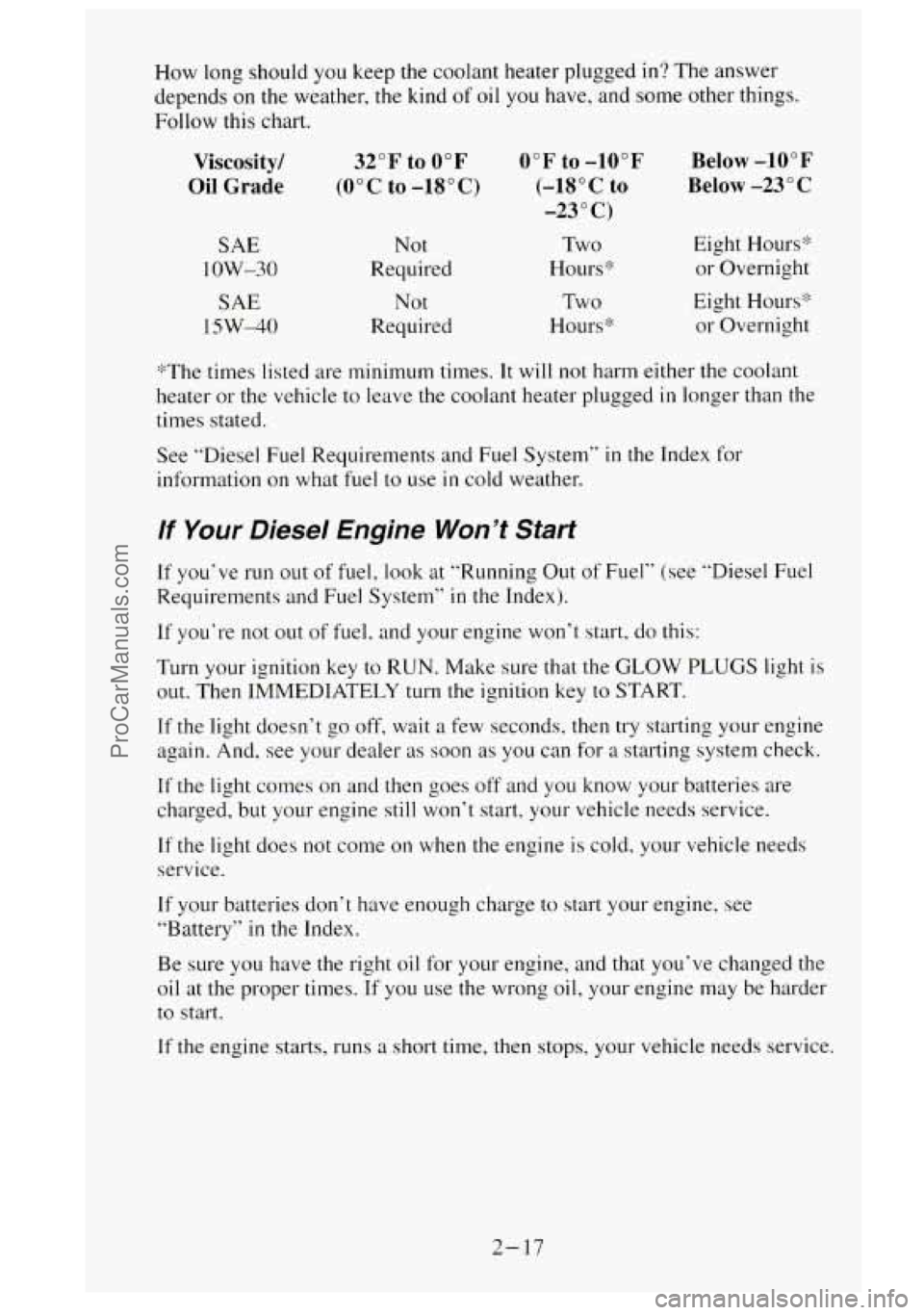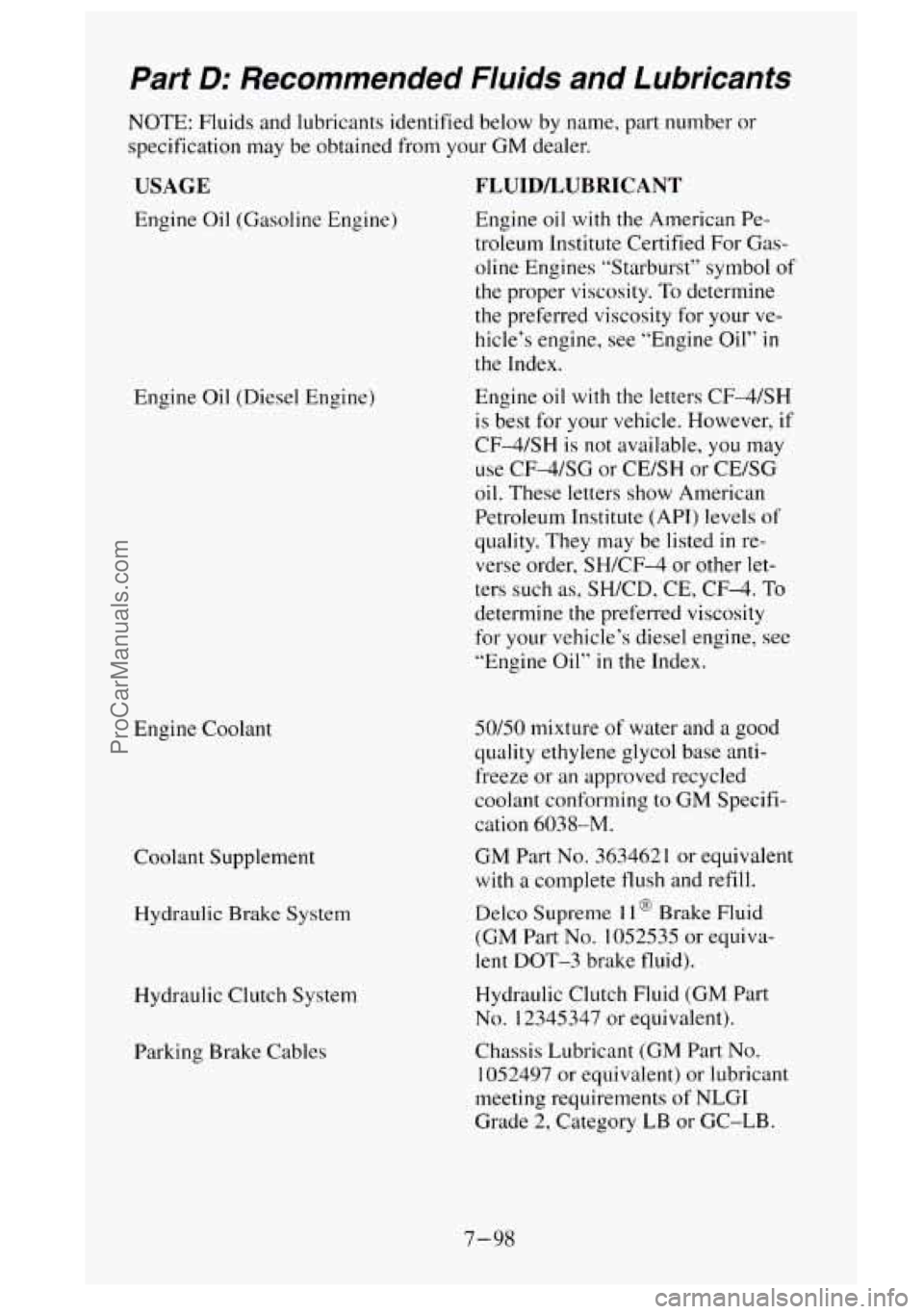Page 79 of 488

How long should you keep the coolant heater plugged in? The answer
depends on the weather,
the kind of oil you have, and some other things.
Follow this chart.
Viscosity/
Oil Grade
SAE
1 OW-30
SAE
15W-40
32°F to 0°F
(0°C to -18°C)
Not
Required
Not
Required
0°F to -10°F
(-18OC
to
-23 O C)
Two
Hours:!:
Two
Hours‘%
Below -10°F
Below -23”
C
Eight Hours’>
or Overnight
Eight Hours* or Overnight
’%The times listed are minimum times.
It will not harm either the coolant
heater or the vehicle to leave
the coolant heater plugged in longer than the
times stated.
See “Diesel Fuel Requirements and Fuel System’’
in the Index for
information
on what fuel to use in cold weather.
If Your Diesel Engine Won’t Start
If you‘ve run out of fuel, look at “Running Out of Fuel” (see “Diesel Fuel
Requirements and Fuel System”
in the Index).
If you‘re not out of fuel, and your engine won’t start, do this:
Turn your ignition key to RUN. Make sure that the GLOW PLUGS light is
out. Then IMMEDIATELY turn the ignition key to START.
If the light doesn’t go off, wait a few seconds, then try starting your engine
again. And, see your dealer as soon as
you can for a starting system check.
If the light comes on and then goes off and you know your batteries are
charged, but your engine still won’t start, your vehicle needs service.
If the light does not come on when the engine is cold, your vehicle needs
service.
If your batteries don‘t have enough charge to start your engine, see
“Battery”
in the Index.
Be sure you have the right oil for your engine, and that you’ve changed the
oil at the proper times. If you use the wrong
oil, your engine may be harder
to start.
If the engine starts, runs a short time, then stops, your vehicle needs service.
2- 17
ProCarManuals.com
Page 143 of 488
Oil Pressure Gage
The oil pressure gage shows the engine oil pressure in psi (pounds per
square inch) when the engine is running. Canadian vehicles indicate
pressure
in kPa (kilopascals). Oil pressure may vary with engine speed,
outside temperature and oil viscosity, but readings above the
low pressure
zone indicate the norn~al opcrating ranse.
A reading in the low pressure zone may bc caused by a dangemusly low oil
level or other problem causing low oil pressure. Check your oil as soon as
possible.
A CAUTION:
Don’t keep driving if the oil pressure is low. If you do, your
engine can become
so hot that it catches fire. You or others could
be burned. Check your oil
as soon as possible and have your
vehicle serviced.
NOTICE:
Damage to your engine from neglected oil problems can be
costly and is not covered by your warranty.
2-81
ProCarManuals.com
Page 284 of 488
You should also use the proper viscosity oil for your vehicle, as shown in
the following chart:
LIGHT DUTY EMISSIONS - GASOLINE ENGINES
FOR BEST FUEL ECONOMY AND COLD STARTING, SELECT THE LOWEST
SAE VISCOSITY GRADE 011 FOR THE EXPECTED TEMPERATURE RANGE.
HOT
WEATHER
WEATHER
n
c
.
SAE IOW-30
L
LOOK
FOR THIS
SYMBOL
r31.
ip
L c,
SAE SW-30
PREFERRED
DO NOT USE SAE 2OW-50 OR ANY OTHER
GRADE OIL NOT RECOMMENDED
As shown in the chart, SAE 5W-30 is best for your vehicle. However, you
can use SAE IOW-30 if it’s going to be 0°F (-I 8°C) or above. These
numbers on
an oil container show its viscosity, or thickness. Do not use
other viscosity oils, such as
SAE 2OW-SO.
6-18
ProCarManuals.com
Page 285 of 488
HEAVY DUTY EMISSIONS - GASOLINE ENGINES
RECOMMENDED SAE VISCOSITY GRADE ENGINE OILS ~ ~ ~~~
FOR BEST FUEL ECONOMY AND COLD STARTING, SELECT
THE LOWEST
SAE
VISCOSITY GRADE OIL FOR THE EXPECTED TEMPERATURE RANGE.
HOT
WEATHER
SA€ 5W-30
LOOK
FOR THIS
SYMBOL
SAE 10W-30
PREFERRED
above 0°F (‘1 8°C)
COLD
WEATHER
00 NOT USE SA€ 2OW-50 OR ANY OTHER
GRADE OIL NOT RECOMMENDED
As shown in the chart, SAE 10W-30 is best for your vehicle. However, you
can use SAE SW-30 if it’s going to be colder than 60°F (16°C) before your
next oil change. When it‘s very cold, you should use SAE 5W-30. These
numbers on
an oil container show its viscosity, or thickness. Do not use
other viscosity
oils, such as SAE 2OW-50.
6- 19
ProCarManuals.com
Page 290 of 488
DIESEL ENGINES
RECOMMENDED SAE VISCOSITY GRADE ENGINE OILS
SELECT THE SAE GRADE OIL BASE0 ON
THE EXPECTED TEMPERATURE RANGE
BEFORE NEXT OIL CHANGE
HOT
WEATHER r
:' F
I- 100
+ 60
+ 32
0
-20
- -
-
- -+16
-3 0
- - -16
- - -29
1 +
/c3'
FOR LOOK THIS @
SYMBOL
SAE 1OW-30
- SAE J 30
SAE 15W4
PREFERRED
above 0°F (-1 8°C)
WEATHER
00 NOT USE SAE 2OW-50 OR ANY OTHER
GRADE OIL NOT RECOMMENDED
a SAE 15W-40
As shown in the viscosity chart, SAE 15W-40 is best for your vehicle.
However, you can use
SAE IOW-30 if it's going to be colder than
32°F (0°C) before your next oil change. When it's very cold, below
0°F (-18"C), you should use SAE low-30 to improve cold starting.
Also, SAE 30 may be used at temperatures above freezing, 32°F (0°C).
These numbers on the
oil container show its viscosity, or thickness. Do
not use other viscosity oils such as SAE 10W-40 or SAE 20W-50.
6-24
ProCarManuals.com
Page 454 of 488

Part D: necommended Fluids and Lubricants
NOTE: Fluids and lubricants identified below by name, part number or
specification may be obtained from your
GM dealer.
USAGE
Engine Oil (Gasoline Engine)
Engine Oil (Diesel Engine)
Engine Coolant
Coolant Supplement
Hydraulic Brake System
Hydraulic Clutch System
Parking Brake Cables
FLUIDLUBRICANT
Engine oil with the American Pe-
troleum Institute Certified For Gas-
oline Engines “Starburst” symbol of
the proper viscosity.
To determine
the preferred viscosity for your ve-
hicle’s engine, see “Engine Oil”
in
the Index.
Engine oil with the letters
CF-4/SH
is best for your vehicle. However, if
CF-4/SH is not available,
you may
use CF-4/SG or CE/SH or CE/SG
oil. These letters show American
Petroleum Institute (APT) levels
of
quality. They may be listed in re-
verse order, SHKF-4 or other let-
ters such
as, SHKD, CE, CF-4. To
determine the preferred viscosity
for your vehicle’s diesel engine, see
“Engine Oil” in the Index.
50/50 mixture of water and a good
quality ethylene glycol base anti-
freeze
or an approved recycled
coolant conforming
to GM Specifi-
cation 6038-M.
GM Part No. 3634621 or equivalent
with a complete flush and refill.
Delco Supreme
11 @ Brake Fluid
(GM Part
No. 1052535 or equiva-
lent DOT-3 brake fluid).
Hydraulic Clutch Fluid (GM Part
No. 12345347 or equivalent).
Chassis Lubricant
(GM Part No.
1052497 or equivalent) or lubricant
meeting requirements of NLGI
Grade
2, Category LB or GC-LB.
7-98
ProCarManuals.com